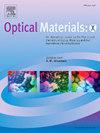重离子辐照时的温度因素对碳化硅陶瓷结构紊乱的影响
Q2 Engineering
引用次数: 0
摘要
本文介绍了重离子辐照对碳化硅陶瓷晶体结构和电子密度分布形成各向异性畸变的影响结果。利用拉曼光谱方法和 X 射线衍射方法获得的结构变化数据,对受损层的性质变化进行了评估。观察到的光谱模式 E1(TO)、E2(TO) 和 A1(LO)的变化取决于辐照温度,这表明结构发生了各向异性的畸变,这种畸变与辐照温度以及辐照所用离子的类型有明显的关系。对两种离子辐照的电子密度分布随辐照温度变化的评估结果表明,辐照温度增长与化学键变形导致的电子密度各向异性畸变之间存在直接关联。反过来,热加热和电离过程的综合效应也会导致化学键的变形畸变,这种畸变在高辐照温度下最为明显,因为晶格的热膨胀和空位缺陷的加速扩散在无序化过程中起着关键作用。本文章由计算机程序翻译,如有差异,请以英文原文为准。
The effect of temperature factor during heavy ion irradiation on structural disordering of SiC ceramics
The paper presents the results of the influence of heavy ion irradiation on the formation of anisotropic distortions of the crystal structure and electron density distribution in SiC ceramics. The assessment of the change in the properties of the damaged layer was carried out using Raman spectroscopy methods, and using data on structural changes obtained using the X-ray diffraction method. The observed alterations in the spectral modes E1(TO), E2(TO) and A1(LO) depending on the irradiation temperature indicate an anisotropic distortion of the structure, which has a clearly expressed dependence on the irradiation temperature, as well as the type of ions used for irradiation. The assessment results of changes in the electron density distribution contingent upon the irradiation temperature for both types of ion irradiation showed a direct correlation between the irradiation temperature growth and the electron density anisotropic distortion caused by the deformation of chemical bonds. In turn, the combination of the effects of thermal heating and ionization processes causes deformation distortion of chemical bonds, which is most pronounced at high irradiation temperatures, for which thermal expansion of the crystal lattice and accelerated diffusion of vacancy defects play a key role in disordering.
求助全文
通过发布文献求助,成功后即可免费获取论文全文。
去求助
来源期刊

Optical Materials: X
Engineering-Electrical and Electronic Engineering
CiteScore
3.30
自引率
0.00%
发文量
73
审稿时长
91 days
 求助内容:
求助内容: 应助结果提醒方式:
应助结果提醒方式:


